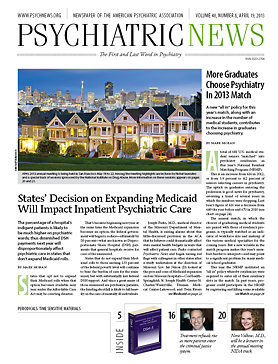There is ample evidence that delusions sometimes lead to violent behavior. But when and why they do so has not been clear.
Now a new study appears to shed light on this complex subject. It looks as if delusions can trigger serious violence when the delusions imply threat and when the threat then leads to anger. The study was conducted by Simone Ullrich, Ph.D., of Queen Mary University of London and colleagues and published March 6 in JAMA Psychiatry.
“That anger induced by certain types of delusional thoughts is a causal link in the chain that leads to violence is theoretically plausible and in accordance with clinical experience,” Paul Appelbaum, M.D., said during an interview. Appelbaum, the Dollard Professor of Psychiatry, Medicine, and Law and director of the Division of Law, Ethics, and Psychiatry at Columbia University and chair of the APA Committee on Judicial Action, has also researched the relationship between delusions and violence.
The study included 458 subjects with first-episode psychosis who were from an economically deprived inner-city area. The researchers used several instruments to learn what percentage of the subjects had engaged in violence during the year prior to the subjects’ first contact with mental health services; whether subjects’ delusions during that period had been linked with violence; and if so, whether any particular affect or intervention had mediated the delusion-violence link.
Thirty-eight percent of the cohort had engaged in violence during the year preceding their first contact with mental health services, and 12 percent had engaged in serious violence during that period. Among the seriously violent subgroup, significantly more were male, younger, had comorbid antisocial personality disorder, and used drugs.
Three types of delusions demonstrated significant associations with serious violence—those whose content involved being spied on, persecuted, and the object of a conspiracy. Moreover, anger due to such threatening delusions was significantly associated with serious violence. No significant associations were found, however, between violent behavior and the affective states of anxiety, fear, or elation due to delusional beliefs; depression actually had a protective effect against violence.
“Anger due to delusions appeared to constitute the main drive to serious violence,” Ullrich and her colleagues concluded. “However, no currently available instrument can differentiate between anger due to a delusion and anger as part of the delusion itself. This differentiation would have testable implications for treatment interventions aimed to prevent future violence among deluded patients. If the anger is reactive to the delusional belief, it may be modifiable by treatment that specifically targets the anger. However, if it is part of the delusion itself, this would imply that treatment must simultaneously target the delusion and the associated anger.”
“The authors suggest that treatment directed at angry thoughts could reduce violent outcomes, and that’s certainly worth testing,” Appelbaum commented. “But we shouldn’t lose focus in reducing the strength of the delusions themselves.”
The study was funded by St. Bartholomew’s Hospital, the Royal London Hospital Special Trustees, the East London NHS Foundation Trust Research and Development, and the U.K. National Institute for Health Research. ■

